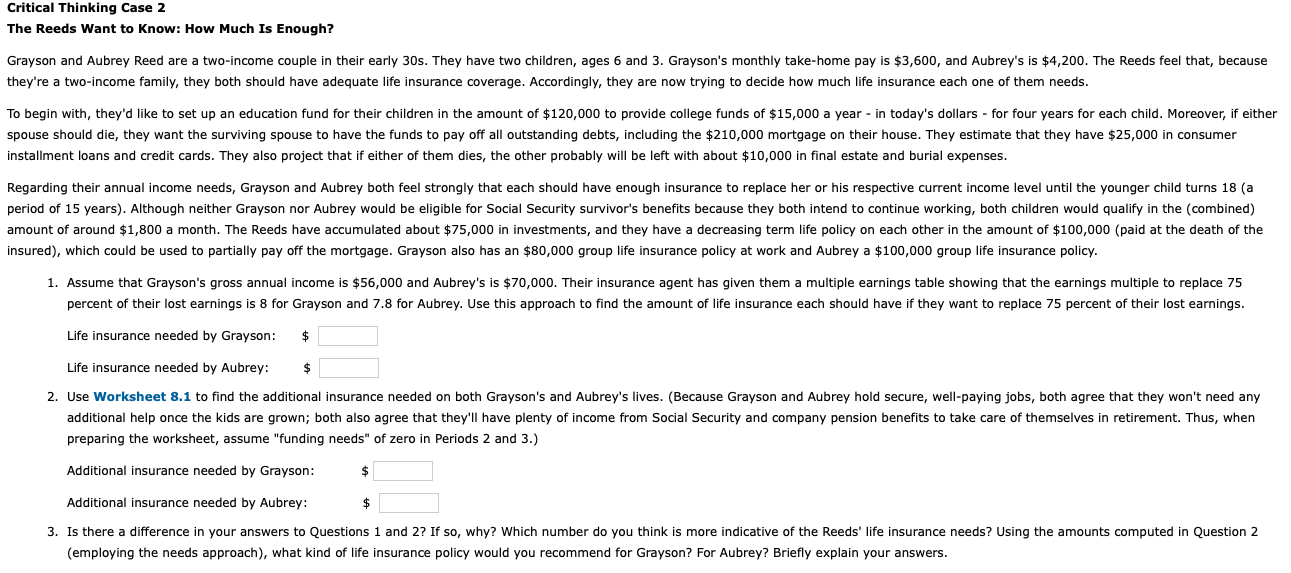
Critical Thinking Case 2 The Reeds Want to know: How Much Is Enough? Grayson and Aubrey Reed are a two-income couple in their early 30s. They have two children, ages 6 and 3. Grayson's monthly take-home pay is $3,600, and Aubrey's is $4,200. The Reeds feel that, because they're two-income family, they both should have adequate life insurance coverage. Accordingly, they are now trying to decide how much life insurance each one of them needs. To begin with, they'd like to set up an education fund for their children in the amount of $120,000 to provide college funds of $15,000 a year - in today's dollars - for four years for each child. Moreover, if either spouse should die, they want the surviving spouse to have the funds to pay off all outstanding debts, including the $210,000 mortgage on their house. They estimate that they have $25,000 in consumer installment loans and credit cards. They also project that if either of them dies, the other probably will be left with about $10,000 in final estate and burial expenses. Regarding their annual income needs, Grayson and Aubrey both feel strongly that each should have enough insurance to replace her or his respective current income level until the younger child turns 18 (a period of 15 years). Although neither Grayson nor Aubrey would be eligible for Social Security survivor's benefits because they both intend to continue working, both children would qualify in the combined) amount of around $1,800 a month. The Reeds have accumulated about $75,000 in investments, and they have a decreasing term life policy on each other in the amount of $100,000 (paid at the death of the insured), which could be used to partially pay off the mortgage. Grayson also has an $80,000 group life insurance policy at work and Aubrey a $100,000 group life insurance policy. 1. Assume that Grayson's gross annual income is $56,000 and Aubrey's is $70,000. Their insurance agent has given them a multiple earnings table showing that the earnings multiple to replace 75 percent of their lost earnings is 8 for Grayson and 7.8 for Aubrey. Use this approach to find the amount of life insurance each should have if they want to replace 75 percent of their lost earnings. Life insurance needed by Grayson: $ Life insurance needed by Aubrey: $ 2. Use Worksheet 8.1 to find the additional insurance needed on both Grayson's and Aubrey's lives. (Because Grayson and Aubrey hold secure, well-paying jobs, both agree that they won't need any additional help once the kids are grown; both also agree that they'll have plenty of income from Social Security and company pension benefits to take care of themselves in retirement. Thus, when preparing the worksheet, assume "funding needs" of zero in Periods 2 and 3.) Additional insurance needed by Grayson: $ Additional insurance needed by Aubrey: $ 3. Is there a difference in your answers to Questions 1 and 2? If so, why? Which number do you think is more indicative of the Reeds' life insurance needs? Using the amounts computed in Question 2 (employing the needs approach), what kind of life insurance policy would you recommend for Grayson? For Aubrey? Briefly explain your answers. Critical Thinking Case 2 The Reeds Want to know: How Much Is Enough? Grayson and Aubrey Reed are a two-income couple in their early 30s. They have two children, ages 6 and 3. Grayson's monthly take-home pay is $3,600, and Aubrey's is $4,200. The Reeds feel that, because they're two-income family, they both should have adequate life insurance coverage. Accordingly, they are now trying to decide how much life insurance each one of them needs. To begin with, they'd like to set up an education fund for their children in the amount of $120,000 to provide college funds of $15,000 a year - in today's dollars - for four years for each child. Moreover, if either spouse should die, they want the surviving spouse to have the funds to pay off all outstanding debts, including the $210,000 mortgage on their house. They estimate that they have $25,000 in consumer installment loans and credit cards. They also project that if either of them dies, the other probably will be left with about $10,000 in final estate and burial expenses. Regarding their annual income needs, Grayson and Aubrey both feel strongly that each should have enough insurance to replace her or his respective current income level until the younger child turns 18 (a period of 15 years). Although neither Grayson nor Aubrey would be eligible for Social Security survivor's benefits because they both intend to continue working, both children would qualify in the combined) amount of around $1,800 a month. The Reeds have accumulated about $75,000 in investments, and they have a decreasing term life policy on each other in the amount of $100,000 (paid at the death of the insured), which could be used to partially pay off the mortgage. Grayson also has an $80,000 group life insurance policy at work and Aubrey a $100,000 group life insurance policy. 1. Assume that Grayson's gross annual income is $56,000 and Aubrey's is $70,000. Their insurance agent has given them a multiple earnings table showing that the earnings multiple to replace 75 percent of their lost earnings is 8 for Grayson and 7.8 for Aubrey. Use this approach to find the amount of life insurance each should have if they want to replace 75 percent of their lost earnings. Life insurance needed by Grayson: $ Life insurance needed by Aubrey: $ 2. Use Worksheet 8.1 to find the additional insurance needed on both Grayson's and Aubrey's lives. (Because Grayson and Aubrey hold secure, well-paying jobs, both agree that they won't need any additional help once the kids are grown; both also agree that they'll have plenty of income from Social Security and company pension benefits to take care of themselves in retirement. Thus, when preparing the worksheet, assume "funding needs" of zero in Periods 2 and 3.) Additional insurance needed by Grayson: $ Additional insurance needed by Aubrey: $ 3. Is there a difference in your answers to Questions 1 and 2? If so, why? Which number do you think is more indicative of the Reeds' life insurance needs? Using the amounts computed in Question 2 (employing the needs approach), what kind of life insurance policy would you recommend for Grayson? For Aubrey? Briefly explain your answers







